The 1911 Wheat penny holds significant value due to its status as an early issue in the Lincoln cent series. By 1911, this was only the third year of production since the U.S. Mint introduced Abraham Lincoln’s portrait on the obverse.
At the time, Americans generally welcomed the new design, though some objected to featuring a real person on the nation’s coinage. This was controversial because George Washington had discouraged such practices, considering them too European and monarchical.
1911 Wheat Penny Value Chart
| Condition | 1911 (No Mint Mark) Penny | 1911-D Penny | 1911-S Penny |
|---|---|---|---|
| Good | $0.60 | $7.13 | $37 |
| Very Good | $0.84 | $9.79 | $48 |
| Fine | $1.84 | $15 | $59 |
| Very Fine | $3.01 | $37 | $79 |
| Extra Fine | $9.79 | $79 | $101 |
| AU (About Uncirculated) | $14 | $101 | $141 |
| MS 60 (Mint State 60) | $24 | $129 | $244 |
| MS 63 (Mint State 63) | $59 | $174 | $428 |
| PR 63 (Proof 63) | $807 | N/A | N/A |
As shown in the chart, the value of a 1911 Wheat penny depends on its mint mark and condition. The 1911-S penny is the most valuable due to its lower mintage, while the 1911 (Philadelphia) penny is more common and typically worth less.
History of the 1911 Wheat Penny

The Lincoln cent was first introduced in 1909 and remained in circulation for over 50 years with only slight design modifications. After that period, the reverse design began changing every half-century, marking significant anniversaries of Abraham Lincoln’s birth.
Each new design was intended to commemorate Lincoln’s legacy while maintaining a simple, cost-effective minting process.
1911 Wheat Penny Minting Figures
| Mint Location | Year | Mintage |
|---|---|---|
| Philadelphia | 1911 (No Mint Mark) | 101,176,054 |
| Philadelphia | 1911 Proof | 1,733 |
| San Francisco | 1911-S | 4,026,000 |
| Denver | 1911-D | 12,672,000 |
| Total Mintage | — | 117,875,787 |
A significant departure from early U.S. coinage tradition was the inclusion of Abraham Lincoln’s portrait on the obverse. Before 1909, U.S. coins primarily featured symbolic images, following George Washington’s advice to avoid depicting real individuals—a practice he believed resembled European monarchies.
However, Lincoln’s unparalleled historical significance led to his portrayal on the cent, making him the first real person to appear on a U.S. coin.
Features of the 1911 Wheat Penny
Victor D. Brenner played a crucial role in shaping American coinage history, as he was responsible for designing the first U.S. circulating coin to feature a real person on the obverse. His design of the Lincoln cent introduced an enduring tribute to Abraham Lincoln, a decision that set a precedent for future U.S. coins.
Thanks to the two wheat stalks on the reverse, these coins became popularly known as “Wheat pennies.” The U.S. Mint produced them from 1909 to 1958, after which the reverse design was changed to feature the Lincoln Memorial. This marked a significant shift in the cent’s appearance while maintaining Lincoln’s iconic presence on the obverse.
The obverse of the 1911 Wheat Penny

Like all Lincoln cents, the 1911 penny features Abraham Lincoln’s profile prominently on the obverse. The portrait is centered vertically and extends down to the lower rim of the coin.
Since the Coinage Act of 1865 mandated certain mottos on U.S. currency, every Lincoln cent has included key inscriptions:
- “IN GOD WE TRUST” – This national motto reflects the belief that America’s political and economic strength comes from divine providence.
- “LIBERTY” – This word symbolizes the American ideal of freedom and democracy, often personified as the mythical goddess Liberty, who is also represented in the Statue of Liberty.
- “1911” – This marks the year of minting, and below the date, Denver (D) and San Francisco (S) mint marks appear—except for Philadelphia-minted coins, which have no mint mark.
Unlike the 1909 VDB Lincoln pennies, the VDB initials (for designer Victor D. Brenner) were removed from the design and did not reappear until 1918, when they were subtly placed on the obverse.
The reverse of the 1911 Wheat Penny
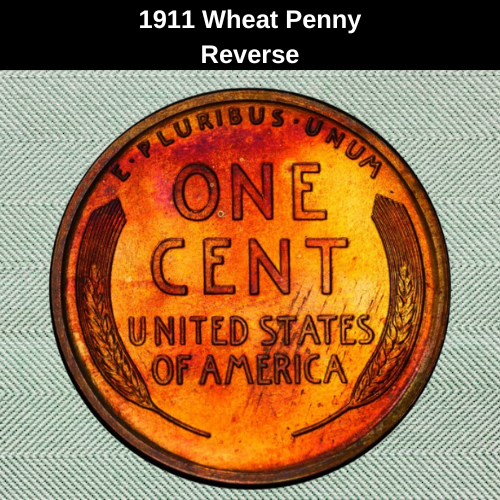
The reverse of the 1911 Wheat Penny features a simple yet iconic design.
- Two wheat ears line the left and right rims, giving the coin its well-known nickname, the Wheat Penny.
- “E PLURIBUS UNUM” appears at the top, a Latin phrase meaning “Out of many, one,” symbolizing the unity of the United States.
- The center of the coin displays:
- “UNITED STATES OF AMERICA” – The official name of the country.
- “ONE CENT” – The denomination of the coin.
1911 Wheat Penny Specifications
- Face value: 1 cent ($0.01)
- Shape: Round
- Composition: 95% copper, 5% zinc and tin
- Thickness: 1.52 mm (0.0598 inches)
- Diameter: 19.05 mm (0.75 inches)
- Weight: 3.11 g (0.10970 ounces)
- Edge: Plain (smooth)
Other features of the 1911 Wheat Penny
All Wheat pennies, including those minted in 1911, follow the standard specifications for U.S. one-cent coins of that era. These coins are composed primarily of copper and have consistent measurements across all mints.
1911 Wheat Penny Dimensions & Composition:
- Weight: 3.11 grams (0.10970 ounces)
- Thickness: 1.52 mm (0.0598 inches)
- Diameter: 19.05 mm (0.75 inches)
- Composition: 95% copper, 5% zinc and tin
- Edge: Plain (smooth)
These coins remain a staple in numismatic collections due to their historical significance and enduring appeal.
1911 Wheat Penny Grading
Grading a 1911 Wheat Penny is essential for accurately determining its value. The Sheldon Scale is the standard grading system used by collectors and appraisers to assess a coin’s condition.
Steps to Grade a 1911 Wheat Penny:
- Examine Circulation Wear – Check for signs of wear, scratches, or dents.
- Observe Surface Details – Look for sharpness in Lincoln’s profile and the wheat ears on the reverse.
- Identify Errors – Rare errors can significantly increase a penny’s worth.
- Consult an Expert – A professional appraiser can certify your coin and provide an accurate valuation.
Sheldon Coin Grading Scale for the 1911 Wheat Penny:
| Grade | Description |
|---|---|
| 1 | Basal State-1 (Barely identifiable) |
| 2 | Fair (Major details worn away) |
| 3 | Very Fair (More visible but still heavily worn) |
| 4-6 | Good (Most details flat but visible) |
| 7-10 | Very Good (Some details clearer) |
| 12-15 | Fine (Moderate wear but strong design elements) |
| 20-30 | Very Fine (Slight wear, strong details) |
| 40 | Extremely Fine (Light wear, clear definition) |
| 50 | About Uncirculated (Minimal signs of wear) |
| 60+ | Mint State (No wear, may have minor imperfections) |
Coins graded MS60-MS70 are in uncirculated condition and command the highest prices. If you suspect your 1911 Wheat Penny is rare or in exceptional condition, consider professional grading for certification and valuation.
1911 Wheat Penny Value Guides
In 1911, three different U.S. mints produced Lincoln Wheat pennies. However, the Philadelphia Mint was the primary contributor, striking the majority of the coins that year.
1911 Lincoln Cent Mintage Breakdown:
- Philadelphia Mint (No Mint Mark): 101,176,054 coins
- Philadelphia Mint Proof Coins: 1,733 coins
- San Francisco Mint (S Mint Mark): 4,026,000 coins
- Denver Mint (D Mint Mark): 12,672,000 coins
- Total Mintage: 117,875,787 coins
Philadelphia was also the only mint that struck proof coins in 1911. These proof pennies are highly sought after due to their sharp details and limited mintage.
1911 no mint mark Wheat Penny Value
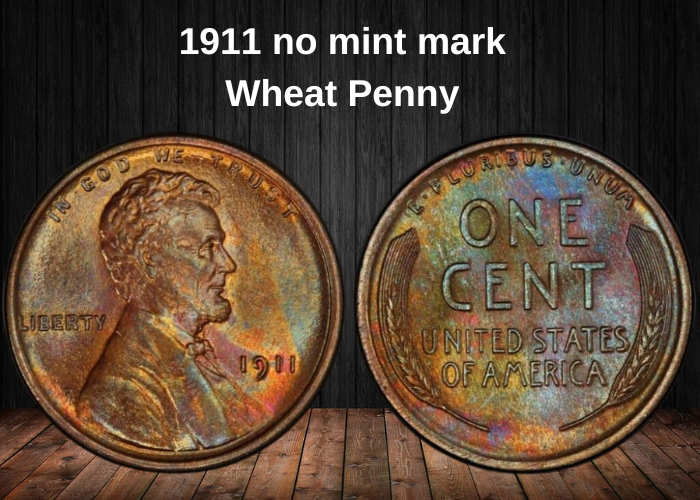
The 1911 Philadelphia Mint Lincoln penny had the highest mintage of that year, with 101,176,054 coins struck. The value of these coins depends on their condition (grade) and color classification (Brown, Red-Brown, or Red).
1911 (P) Lincoln Penny Value by Grade & Color:
Brown (BN) Pennies:
- Circulated condition: $0.30 – $13
- Mint State (Uncirculated): $38 (MS 60) – $225 (MS 65)
- Auction Record (2019, MS 65 BN): $3,290
Red-Brown (RB) Pennies:
- MS 63: $70
- MS 64: $135
- MS 65: $325
- MS 66 (Most collectible): $550
- Auction Record (2012, MS 65 CAC RB): $1,175
Red (RD) Pennies (Most Valuable & Sought After):
- MS 63: $110
- MS 67: $9,500
- MS 68 (Estimated): $125,000 (No auction record exists)
- Auction Record (MS 67 RD): $21,850
Red-colored coins tend to fetch the highest prices due to their superior luster and well-preserved surfaces.
1911 Wheat Penny Value (proof)
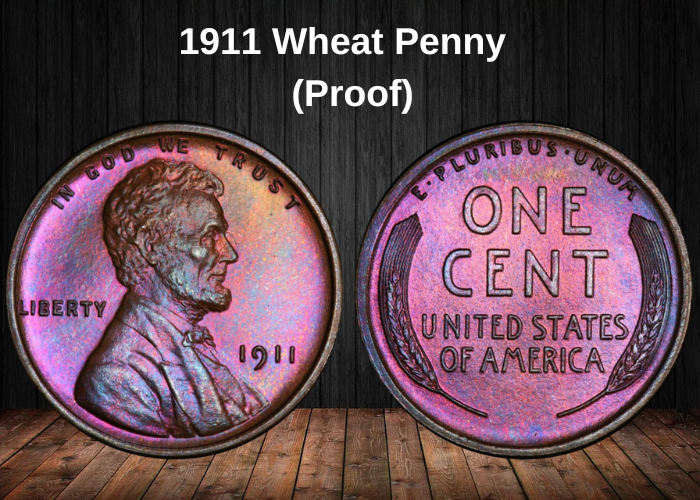
The 1911 Proof Lincoln pennies from the Philadelphia Mint are highly valued, and their prices depend on their color and grade. Here’s a breakdown:
1911 Proof Lincoln Penny Value by Color & Grade:
Brown (BN) Proof Pennies:
- PR 60 to PR 67: $385 – $9,000
- Auction Record: One brown proof penny sold for $8,225.
Red-Brown (RB) Proof Pennies:
- PR 60 to PR 66: $400 – $4,250
- Auction Record: The highest-selling red-brown proof pieces have gone for over $14,000.
Red (RD) Proof Pennies (Most Expensive):
- PR 60 to PR 67: $675 – $9,600
- Auction Record: The most valuable red proof pennies have fetched over $14,000.
The red and red-brown proofs, particularly those with higher grades, can command very high prices, especially when they appear in auction settings.
1911 D Wheat Penny Value
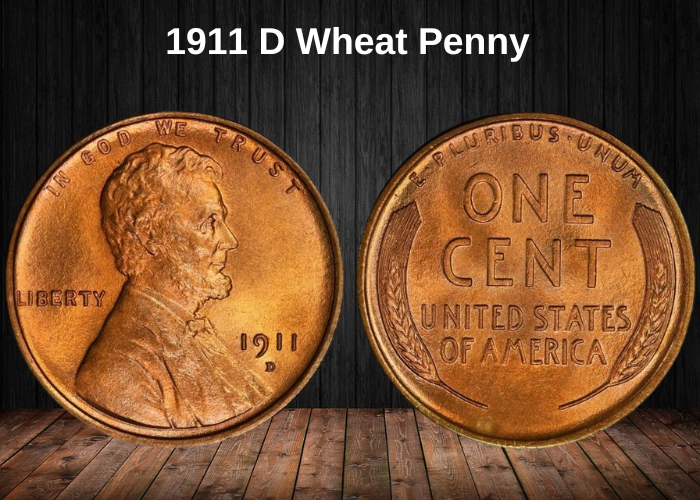
The 1911 D (Denver) Wheat pennies are highly valued, with prices varying based on color and condition. Here’s a breakdown of their value:
1911 D Wheat Penny Value by Color & Grade:
Brown (BN) Coins:
- Circulated Condition: $4.50 – $77
- MS 65 Grade (Mint State): Around $550.
Red-Brown (RB) Coins:
- MS 63 Grade: $235
- MS 66 Grade: $1,400.
Red (RD) Coins (Most Expensive):
- MS 63 Grade: $265
- MS 64 Grade: $600
- MS 65 Grade: $1,050
- MS 66 Grade: $1,950
- MS 67 Grade: $60,000
Auction Records:
- Brown and Red-Brown Coins: Around $1,500.
- Red Coins: A red penny reached a record price of $66,000 at an auction in 2022.
As with other Lincoln pennies, the red coins, especially those graded MS 67, are significantly more valuable than the brown or red-brown coins.
1911 S Wheat Penny Value
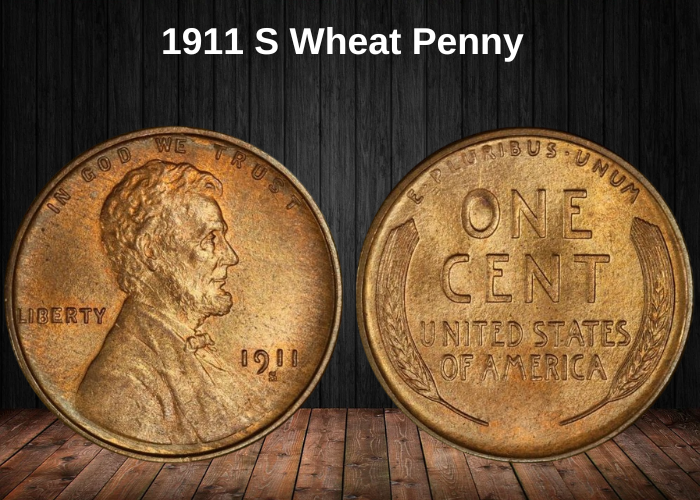
The 1911 S Wheat pennies, minted in San Francisco, have the lowest mintage at 4,026,000 coins, which makes them relatively rare and valuable. Here’s a breakdown of their value based on color and grade:
1911 S Wheat Penny Value by Color & Grade:
Brown (BN) Coins:
- Circulated Condition: $22 – $140
- Mint State (MS 60 – MS 65): $225 – $1,350
Red-Brown (RB) Coins:
- MS 61 Grade: $260
- MS 65 Grade: $1,450
- MS 66 Grade: $4,750
Red (RD) Coins (Most Expensive):
- MS 61 Grade: $300
- MS 64 Grade: $875
- MS 65 Grade: $2,350
- MS 66 Grade: $17,500
Auction Record:
- Red Coin (MS 66): The highest price ever paid for a 1911 S red penny was $27,600.
As with other Lincoln cents, red pennies from San Francisco are the most desirable and valuable, especially those graded MS 65 or higher.
Rare 1911 Wheat Penny Errors List
When it comes to 1911 Lincoln Wheat pennies (or any older coins), it’s essential for collectors to differentiate between mint-made errors and post-mint damage. Here’s a guide to help you identify the more valuable errors:
Re-punched mint mark

The re-punched mint mark error is a sought-after mistake among collectors, especially for 1911 pennies, which were struck in large numbers at multiple mints. Here’s a closer look at the coins with this error:
1911 Re-punched Mint Mark Error
- Re-punched mint mark errors occur when a mintmark is stamped multiple times, sometimes with slight misalignment, resulting in a doubled or altered appearance of the mintmark. This is an interesting and valuable error to look for.
1911 Coins with the Re-punched Mint Mark Error
- 1911 S/S (San Francisco Mint):
- The 1911 S/S penny is one of the most famous re-punched mint mark coins.
- Auction Record: A 1911 S/S penny in MS 65 with a brown toning fetched an auction record of $1,750 in 2022. A similar coin with red-brown toning sold for $1,320 in 2019.
- These coins are quite rare, and their prices reflect that rarity, especially in higher grades.
- 1911 D/D (Denver Mint):
- The 1911 D/D penny is another common example of a re-punched mint mark error, though less rare than the S/S version.
- Auction Records: 1911 D pennies with the re-punched mintmark error can sell for around $1,000 in good condition, depending on their grade.
- Minted in larger quantities, making them more accessible, though still valuable among error coin collectors.
- Philadelphia Coins:
- Since Philadelphia struck the 1911 pennies without a mintmark, there are no re-punched mint mark errors from this mint.
- This makes coins from Philadelphia a bit more straightforward to assess and collect, with no need to worry about mintmark errors.
Value and Rarity
- 1911 S/S and D/D pennies with re-punched mint marks are much rarer and more valuable than their regular counterparts.
- These errors can add substantial value to the coin, depending on their grade and toning.
For example:
- Brown-toned coins are generally more affordable than red-brown or red-toned coins, but still fetch a premium if they are well-graded.
- High-grade coins (MS 65 and above) can command substantial prices at auction, especially if they have the re-punched mint mark error.
If you’re a collector or investor, these re-punched mint mark pennies are a great addition to your collection and an opportunity to own a piece of rare U.S. coin history.
Lamination
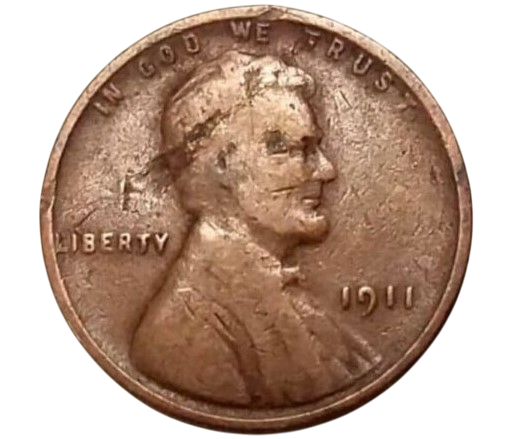
This error happens when metal fragments or debris become trapped in the metal strip during the minting process. As a result, the coin ends up with a metal fragment or a raised bump on its surface. You should expect to pay around $100 to $150 for one of these pieces, depending on its condition and the size of the defect.
FAQ about the 1911 Wheat Penny
What makes a 1911 Wheat Penny rare?
While most 1911 pennies are fairly common, especially those in used condition, the rare ones are typically those in the highest grades. Finding these coins in mint condition is quite difficult, even for seasoned collectors with substantial budgets.
Which 1911 Wheat Penny is worth a lot of money?
Here are some of the most valuable 1911 Wheat pennies:
- 1911 D MS 67 RD penny – $66,000 (2022)
- 1911 S MS 66 RD penny – $27,600 (2007)
- 1911 MS 67 RD penny – $21,850 (2007)
- 1911 PR 66 RD penny – $14,950 (2005)
- 1911 PR 66 RB penny – $14,688 (2014)
- 1911 PR 67 BN penny – $8,225 (2017)
- 1911 S MS 66 RB penny – $3,840 (2019)
- 1911 MS 65 BN penny – $3,290 (2019)
- 1911 S MS 65 BN penny – $2,991 (2006)
- 1911 S/S MS 65 BN RPM penny – $1,750 (2022)
- 1911 D MS 63 RB penny – $1,500 (2022)
- 1911 D AU 58 BN penny – $1,438 (2010)
- 1911 S/S MS 65 RB RPM penny – $1,320 (2019)
- 1911 MS 65 CAC RB penny – $1,175 (2012)
- 1911 D/D VF 25 BN RPM penny – $1,006 (2022)
- 1911 MS 65 penny – $916 (2022)
- 1911 D/D MS 64 BN RPM BN penny – $910 (2022)
How much is the 1911 No Mint mark Wheat Penny worth?
The value of the 1911 no mint mark Wheat penny depends on its grade and color. Brown pennies in circulated condition from Philadelphia are usually worth up to $13, with even the most expensive examples rarely exceeding $120.
Red-brown pennies from this year typically range in value from $30 to $400, based on quality. Red pennies are often more valuable, with prices ranging from $100 to $6,600 for well-preserved specimens. Those in the highest MS 68 grade are extremely rare, with prices reaching between $75,000 and $100,000.
What penny is the costliest in the Wheat series?
The most expensive Type 1 Wheat reverse penny is the 1944 San Francisco mint penny, which sold for $408,000 in 2021 due to its uniqueness, MS 66 grade, and steel composition.
However, the 1943 Denver Type 2 penny, which is a bronze penny in MS 64 grade, surpassed it in price, fetching $840,000 at an auction in 2021. Following that, the 1909 proof penny with VDB in PR 67+ grade holds the third spot, with a sale price of $258,500 in 2014.



















































